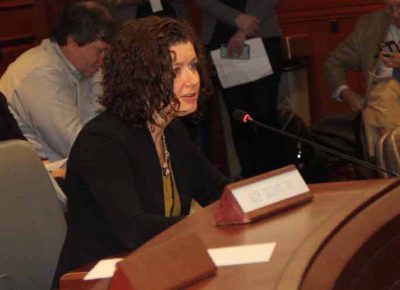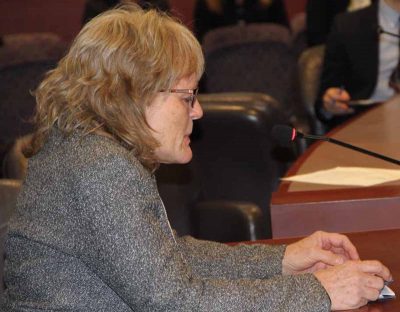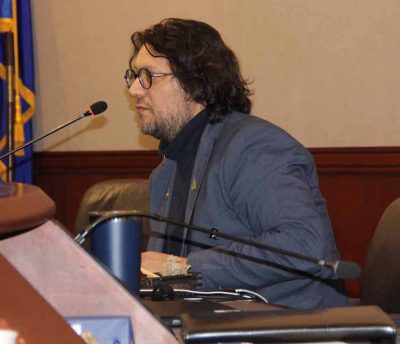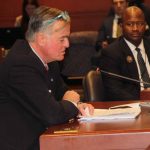
Story and photos by Judy Benson
Hartford — Sound science, an open and transparent process, and a treasure trove of facts, figures and maps available to everyone — those are some of the attributes speakers ascribed to the Long Island Sound Blue Plan at a public hearing before the Environment Committee of the State Legislature on Feb. 21.
“It’s really exciting to be getting to this milestone,” said Katie Dykes, commissioner of the state Department of Energy and Environmental Protection, who was the first of more than a dozen speakers to testify about the plan. DEEP joined Connecticut Sea Grant and Connecticut Chapter of The Nature Conservancy in leading the creation of the plan over the last four years.
Dykes emphasized that the plan is not a regulatory document, but an information resource that will help avoid conflicts and protect current uses and users.
As Peter Auster, a member of the Ecological Experts Working Group put it in his testimony, “the plan helps us better navigate where the guardrails ought to be.” Auster is the senior research scientist at Mystic Aquarium and professor emeritus of marine sciences at UConn.
A final draft of the 514-page document — the first marine spatial plan for the Sound, with interactive maps and resource inventories — has been submitted to the Legislature for approval. The purpose of the hearing was to give state officials and the public the chance to weigh in on a pending bill to adopt the plan.

Nancy Balcom, associate director of Connecticut Sea Grant, recounted that the first discussions about the need for a marine spatial plan for the Sound took place in 2010, and that the end result of the years of collaborating and engaging with multiple stakeholders is a vibrant, accessible product. Balcom testified on behalf of Sea Grant Director Sylvain De Guise, who spearheaded Sea Grant’s contributions to the Blue Plan. He also submitted written testimony, as did Tessa Getchis, aquaculture extension specialist at Sea Grant.
“The team sought to make the vast amount of information collected easily accessible, by working with partners and stakeholders to review and distill the information into maps that display special places to be recognized and protected, ecologically significant areas and significant human use areas,” Balcom said. “It gives easy access for everyone to information in a way that is engaging and user friendly.”
While the full document, along with the maps and inventories, has been made available on DEEP’s website, legislators were provided with print copies of a Blue Plan Users Guide to help them navigate through the plan. An electronic version of the Users Guide with active links is also available.
Nathan Frohling, director of marine and coastal initiatives for The Nature Conservancy, noted that the plan is the first to describe and map 29 significant human use areas and 14 ecologically significant areas.
“It identifies what it is we care about, so that when a new proposed use comes along, we have the information we need” to make a good decision, he said.

State Rep. Stephen Meskers, Democrat of Greenwich, and state Sen. Heather Somers, Republican of Groton, were among several legislators who testified in support of the plan but urged the committee to consider strengthening it. Meskers said amendments and updates to the plan should be allowed every 12 to 18 months instead of very five years as it now reads. Somers recommended committee members have a clear understanding of how much it will be relied on for guidance in decisions affecting the Sound, and revise language in the bill to ensure that the information in the plan is taken seriously.
“I hope the Blue Plan will have more weight going forward,” she said.
Joe Gilbert, owner of Empire Fisheries who represented commercial fishermen on Blue Plan panels, said that while he has been publicly supportive of adoption of the plan, he is now ambivalent. While he complements the high quality of the information gathered into the plan, he said he is concerned that “the Blue Plan has no teeth to protect the environment and its resources.”
“How will the Blue Plan be factored in when conflicts cannot be avoided?” he asked.
State Rep. Jonathan Steinberg, Democrat of Westport, however, was unequivocal in his support for adoption of the plan.
“This is indeed a practical and useful document,” he said. “It will help planners of all sorts.”
Approval of the plan, he said, “is as important as any other work the Environment Committee will do this session.”
Judy Benson is the communications coordinator at Connecticut Sea Grant.


